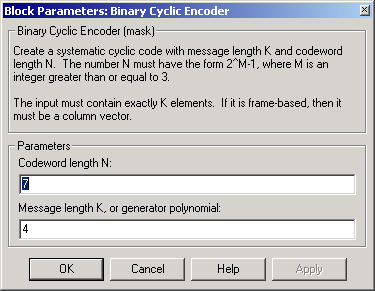| Communications Blockset |
  |
Binary Cyclic Encoder
Create a systematic cyclic code from binary vector data
Library
Block sublibrary of Channel Coding
Description

The Binary Cyclic Encoder block creates a systematic cyclic code with message length K and codeword length N. The number N must have the form 2M-1, where M is an integer greater than or equal to 3.
The input must contain exactly K elements. If it is frame-based, then it must be a column vector. The output is a vector of length N.
You can determine the systematic cyclic coding scheme in one of two ways:
- To create an [N,K] code, enter N and K as the first and second mask parameters, respectively. The block computes an appropriate generator polynomial, namely,
cyclpoly(N,K,'min').
- To create a code with codeword length N and a particular degree-(N-K) binary generator polynomial, enter N as the first parameter and a binary vector as the second parameter. The vector represents the generator polynomial by listing its coefficients in order of ascending exponents. You can create cyclic generator polynomials using the
cyclpoly function in the Communications Toolbox.
Dialog Box

- Codeword length N
- The codeword length, which is also the output vector length.
- Message length K, or generator polynomial
- Either the message length, which is also the input vector length; or a binary vector that represents the generator polynomial for the code.
Pair Block
Binary Cyclic Decoder
See Also
cyclpoly (Communications Toolbox)
 | Binary Cyclic Decoder | | Binary Error Pattern Generator |  |






